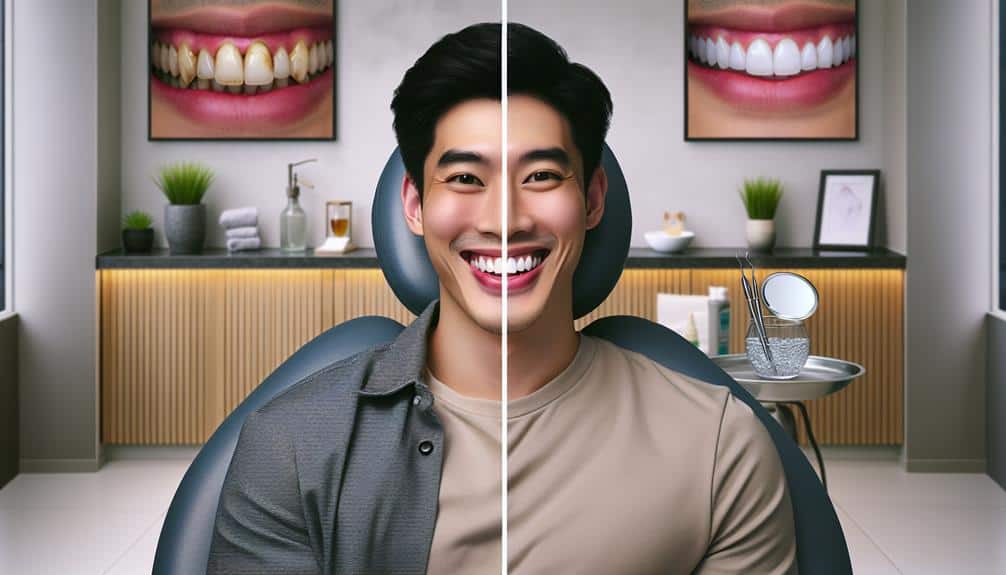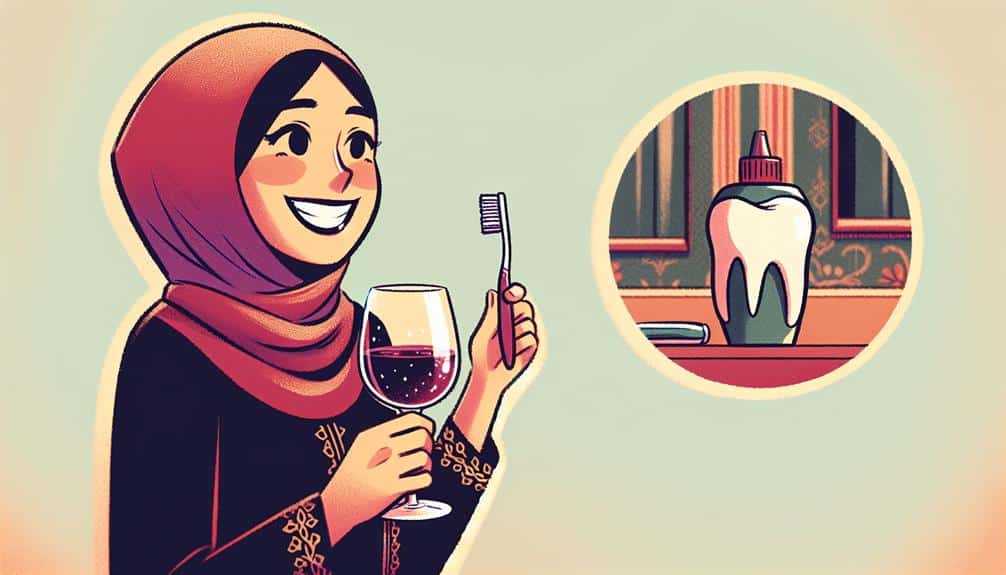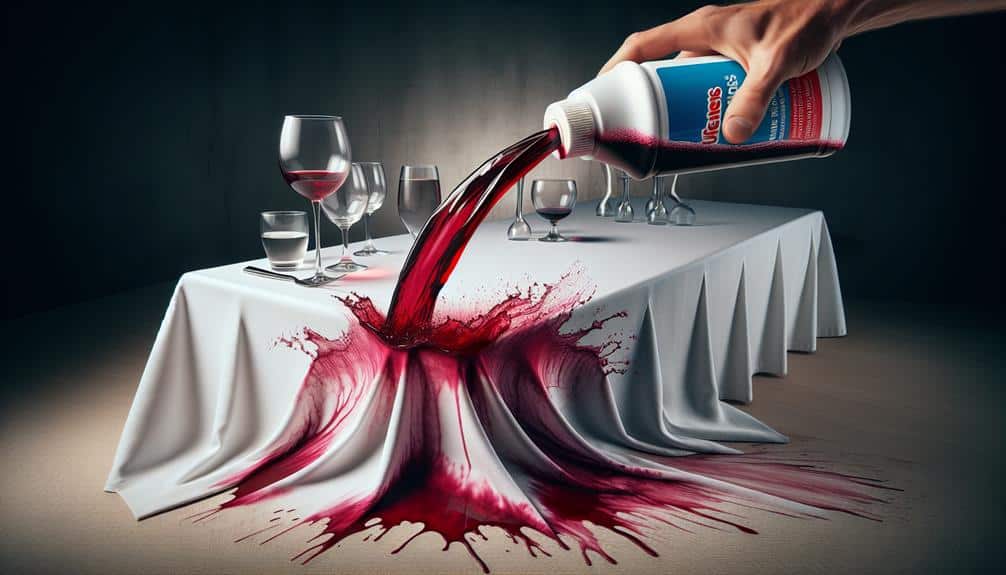Opt for white wine to safeguard your smile from stains caused by red wine's tannins adhering to your enamel. With fewer tannins present in white wine, the risk of dental discoloration is reduced. Rinse with water after drinking to wash away acids and pigments, keeping stains at bay. Using a straw when sipping minimizes direct contact between wine and teeth, preserving your smile's brightness. Brushing your teeth before consuming wine prevents stains and improves your wine-tasting experience. Regular dental cleanings and check-ups are essential for maintaining a healthy, stain-free smile. Prioritize your oral health to enjoy a sparkling smile.
Key Points
- Choose white wine to reduce staining from tannins.
- Rinse with water after drinking to remove acids.
- Use a straw to minimize direct contact with teeth.
- Brush teeth before wine to prevent discoloration.
- Regular dental cleanings help prevent and treat stains.
Choose White Wine Over Red
To prevent wine stains on your teeth, opt for white wine over red. When it comes to wine pairing and dental health, choosing white wine can be a more teeth-friendly option.
Unlike red wine, white wine is less likely to cause significant staining on your teeth due to its lower tannin content. Tannins, which are present in higher amounts in red wine, can adhere to the enamel of your teeth, leading to discoloration over time.
White wine, on the other hand, contains less tannins, reducing the risk of staining.
If you enjoy a glass of wine and want to maintain your dental health, selecting white wine can help minimize the potential for unsightly stains on your teeth. Remember, moderation is key when it comes to wine consumption for both your overall health and dental well-being.
Rinse With Water After Drinking
After enjoying a glass of wine, remember to rinse your mouth with water to help prevent stains on your teeth. Water helps wash away the acids and pigments from the wine, reducing the chances of them sticking to your teeth and causing discoloration. This simple practice is effective in maintaining your smile's brightness after indulging in a glass of your favorite red or white wine.
In addition to regular water rinses, you can also consider using mouthwash to further cleanse your mouth and teeth. Mouthwash rinse helps eliminate bacteria and residue that could contribute to staining, promoting overall oral health.
Another alternative to water rinses is a lemon water rinse. Mixing some lemon juice with water can help neutralize the acidity in your mouth and brighten your teeth. However, be cautious with this method, as the acidity of lemon juice can potentially erode your enamel if used excessively.
Use a Straw When Sipping
Consider using a straw when sipping wine to help minimize direct contact between the wine and your teeth, reducing the risk of staining. When using a straw, it's important to maintain proper straw etiquette. Opt for a reusable straw to be environmentally friendly. Make sure to position the straw towards the back of your mouth to further limit contact between the wine and your teeth.
Mastering the sipping technique with a straw is key. Gently sip the wine through the straw rather than sucking it aggressively. This method can help prevent the wine from swishing in your mouth, thereby reducing its contact with your teeth. Additionally, avoid excessively swirling the wine in your mouth before swallowing.
Brush Teeth Before Wine Consumption
Begin your wine-tasting experience with a clean slate by brushing your teeth before consuming wine. This simple step is one of the most essential preventive measures you can take to avoid wine stains on your teeth. By maintaining good oral hygiene and ensuring your teeth are free of plaque and debris before indulging in wine, you create a smoother surface that's less prone to staining.
Brushing your teeth before drinking wine helps remove any existing plaque and food particles that could potentially interact with the acids and pigments present in wine, leading to discoloration. Additionally, the act of brushing stimulates saliva production, which plays a vital role in neutralizing acids and protecting your teeth from the damaging effects of wine.
Incorporating this practice into your wine-drinking routine not only contributes to better oral hygiene but also enhances your overall wine-tasting experience. Remember, a clean smile is a happy smile, so make sure to prioritize your oral health before raising that glass of wine.
Regular Dental Cleanings and Check-Ups
Regular dental cleanings and check-ups are essential for maintaining excellent oral health and preventing wine stains on teeth. These routine visits to your dentist play an important role in keeping your teeth and gums healthy, which in turn can help minimize the impact of wine stains. During these appointments, your dental hygienist won't only clean your teeth thoroughly but also provide valuable insights into proper flossing techniques and oral hygiene habits.
Flossing is a key component of maintaining a bright smile and preventing stains. Your dental hygienist can demonstrate the most effective flossing techniques tailored to your specific needs, ensuring that you can remove plaque and food particles that brushing alone may miss. Additionally, regular dental cleanings can help address any early signs of staining or discoloration, allowing for prompt intervention and treatment to maintain your smile's vibrancy. By prioritizing these check-ups, you're taking proactive steps towards preserving your oral health and preventing wine stains from detracting from your smile's brilliance.
Frequently Asked Questions
Can Certain Foods or Beverages Help Prevent Wine Stains on Teeth?
To prevent wine stains on teeth, consider wine alternatives like white wine or clear spirits. Your dietary habits also play a role; consuming crunchy fruits and vegetables can naturally scrub away stains. Incorporate these choices for a brighter smile.
Are There Any Natural Remedies That Can Help Remove Wine Stains From Teeth?
To remove wine stains from teeth, consider natural remedies like baking soda and hydrogen peroxide mix. DIY solutions, such as oil pulling with coconut oil, can also help. Regular oral hygiene and whitening treatments further aid in stain removal.
How Long Should I Wait Before Brushing My Teeth After Drinking Wine?
After drinking wine, wait 30 minutes before brushing your teeth to protect enamel weakened by acidity. Brushing immediately can spread stains. Consider using proven methods for wine stain removal and maintaining a bright smile.
Are There Any Specific Toothpastes or Mouthwashes That Can Help Prevent Wine Stains?
When it comes to preventing wine stains on teeth, some toothpaste options can be your knights in shining armor. Look for toothpaste recommendations tailored for stain prevention and pair them with effective mouthwashes for extra dental care.
Can Certain Medications or Health Conditions Make Teeth More Susceptible to Wine Stains?
Certain medications can increase your teeth's susceptibility to wine stains. Health conditions like enamel erosion or dry mouth can also heighten staining risk. Consult with your healthcare provider to understand how these factors may impact your dental health.



